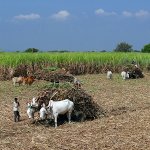Karam (Karma) Harvest Festival in India Date in the current year: September 3, 2026
 Karam (also known as Karma, Karam Puja or Karma Puja) is a traditional harvest festival celebrated by a number of ethnic groups living in the Indian states of Assam, Chhatisgarh, Jharkhand, Madhya Pradesh, Odisha, and West Bengal. In Jharkhand, it even has the status of an official state holiday.
Karam (also known as Karma, Karam Puja or Karma Puja) is a traditional harvest festival celebrated by a number of ethnic groups living in the Indian states of Assam, Chhatisgarh, Jharkhand, Madhya Pradesh, Odisha, and West Bengal. In Jharkhand, it even has the status of an official state holiday.Karam is celebrated on the eleventh day of the Hindu month of Bhadrapada, falling during August or September in the Gregorian calendar. It is dedicated to the deity of the same name, who is venerated as the god of youth and power.
There are several legends that explain the origins of the Karam festival. One of them tells about seven brothers who spent all their time working hard in the field; they didn’t even have time to go home for lunch, so their wives brought food to the field every day. However, one day the wives didn’t bring any food. The brothers returned home in the evening, hungry and angry, and found their wives singing and dancing with a branch of the karam tree.
One of the brothers lost his temper, took the branch from the wives and threw it into the river, which insulted the Karam deity. After that, no matter how hard the brothers worked, their family grew poorer and poorer. One day, they met a Brahmin (priest) who listened to their story and told them that they needed to appease the deity, otherwise they would eventually starve to death. The brothers left the village and went from place to place, looking for the karam tree. They worshiped it, and their lives took a turn for the better.
Another legend tells about a wealthy merchant who returned home after a long voyage in a vessel loaded with valuable goods from distant lands. He expected to be greeted by his wife and relatives at the pier, as custom dictated, but no one came. It turned out, it was day of the Karam festival and the entire village was too engrossed in the celebration. Furious with his family, the merchant threw the karam tree away; naturally, the deity got angry and sank his vessel with all the goods. After realizing what he had done, the merchant set out in search of the deity in another vessel. He found the karam tree floating in the sea and appeased the deity, who restored his wealth.
Girls in rural areas begin preparations for Karam Puja about a week before the festival. They plant nine types of grains (rice, wheat, corn, etc.) in baskets and water then regularly so that they germinate before the holiday begins. On the morning of the holiday, women grind rice in a dheki (a traditional tool) to make rice flour, which is used to prepare traditional treats for the feast.
The karam tree (Neolamarckia cadamba, also known as kadam, burflower-tree or Leichhardt pine) plays the central role in the festivities. In the morning, a group of people accompanied by drummers set out to the jungle to find the karam tree. They worship it, cut off a few branches and bring them back to the village. The branches are symbolically “planted” in the center of the village.
The village priest offers germinated grains and liquor to the deity. After that, people perform a ritual dance with the karam branches, and the priest recites the story behind the celebration of Karam Puja. Villagers spend the entire night singing, dancing and drinking hariya (rice beer), and in the morning, the karam branches are set afloat in the river.
* date for 2025
- Category
- Folk Festivals
- Country
- India
- Tags
- Indian holidays, Indian festivals, traditional festival, harvest festival, folk festival, holidays in Jharkhand